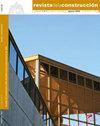工业存储系统连续穿孔立柱:组合式设计方案
IF 1.4
4区 工程技术
引用次数: 0
摘要
巴西冷弯型钢设计标准(ABNT NBR 14762:2010、2010)和托盘架设计标准(ABNT NBR 15524-2:20 7,2007)采用不同的屈曲曲线来确定柱在轴压下的强度。本文旨在评价用冷弯巴西标准屈曲设计曲线代替托盘架设计标准公式的有效性,研究公式在计算竖向抗压强度的计算过程中使用的可行性。该强度的计算方法有四种:一种是采用巴西托盘架标准的原始方程,另一种是采用冷弯型钢设计标准的屈曲曲线。在有限元分析的基础上,对局部、全局和畸变屈曲和缺陷进行了理论和数值分析。此外,还参考了实验结果来确定考虑局部屈曲和连续穿孔影响的研究截面的有效面积。结果表明,修正后的结果与采用ABNT NBR 15524原方程得到的结果一致,表明采用ABNT NBR 14762屈曲曲线的可行性。本文章由计算机程序翻译,如有差异,请以英文原文为准。
Industrial storage system continuous perforated uprights: a combined design proposal
Brazilian standards for design of cold-formed steel (ABNT NBR 14762:2010, 2010) and design of pallet racks (ABNT NBR 15524-2:2007, 2007) have different procedures to determine the strength of columns under axial compression, using different buckling curves. This paper aims to evaluate the efficiency of using cold-formed Brazilian standard buckling design curve instead of the formulations of the pallet-rack design standard to study the use viability of the equations in the calculation procedure for computing the uprights compressive strength. This strength was calculated in four ways: one using the original equations of pallet-rack Brazilian standard, and the other three using adaptations of the buckling curve from the cold-formed steel design standard. A theoretical and numerical procedure based on finite element analysis concerning local, global, and distortional buckling and imperfections was performed. Furthermore, experimental results were also consulted to determine the effective area of studied cross-sections considering the effects of local buckling and the presence of continuous perforations. The results show that the proposed modifications are consistently correlated to the results obtained using the original equations of ABNT NBR 15524, indicating the viability of using the buckling curve of ABNT NBR 14762.
求助全文
通过发布文献求助,成功后即可免费获取论文全文。
去求助
来源期刊

Revista de la Construccion
工程技术-工程:土木
CiteScore
2.30
自引率
21.40%
发文量
0
期刊介绍:
The Journal of Construction is aimed at professionals, constructors, academics, researchers, companies, architects, engineers, and anyone who wishes to expand and update their knowledge about construction. We therefore invite all researchers, academics, and professionals to send their contributions for assessment and possible publication in this journal. The publications are free of publication charges.
OBJECTIVES
The objectives of the Journal of Construction are:
1. To disseminate new knowledge in all areas related to construction (Building, Civil Works, Materials, Business, Education, etc.).
2. To provide professionals in the area with material for discussion to refresh and update their knowledge.
3. To disseminate new applied technologies in construction nationally and internationally.
4. To provide national and foreign academics with an internationally endorsed medium in which to share their knowledge and debate the topics raised.
 求助内容:
求助内容: 应助结果提醒方式:
应助结果提醒方式:


